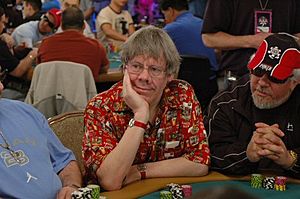Paul Magriel facts for kids
Quick facts for kids Paul Magriel |
|
|---|---|

Magriel in the 2005 World Series of Poker
|
|
| Nickname(s) | X-22; Button |
| Born | Paul David Magriel, Jr. July 1, 1946 Manhattan, New York, U.S. |
| Died | March 5, 2018 (aged 71) Las Vegas, Nevada, U.S. |
| World Series of Poker | |
| Bracelet(s) | None |
| Money finish(es) | 8 |
| Highest ITM Main Event finish |
683, 2010 |
| World Poker Tour | |
| Title(s) | None |
| Final table(s) | 1 |
| Money finish(es) | 2 |
Paul David Magriel Jr. (born July 1, 1946 – died March 5, 2018) was a very smart American professional backgammon and poker player. He also wrote books about games. Paul Magriel lived in Las Vegas, Nevada.
When he was 20 years old, Paul became the New York State Junior Chess Champion. This was in January 1967, while he was a student at New York University.
Contents
Paul Magriel: The Backgammon Master
Paul Magriel was known as X-22 in the world of backgammon. Many people believe he won more big backgammon tournaments than anyone else. He was also thought to be the best backgammon teacher. He was very good at thinking up new strategies for the game.
The nickname X-22 came from a special game Paul played. He pretended to play 64 backgammon games at once. Each game had a number, like X-1, X-2, and so on. The player named "X-22" was the one who won in the end.
Paul first became famous in backgammon when he won the World Backgammon Championship in 1978. From 1977 to 1980, he wrote weekly articles about backgammon for The New York Times newspaper.
Paul and his first wife, Renée Magriel, wrote two important books. One was called Backgammon, which many people call the "bible" of the game. They also wrote a simpler book for new players, An Introduction to Backgammon: A Step-by-Step Guide.
Paul Magriel also appeared on TV. He was a commentator for a show called "High Stakes Backgammon" in 2005. This show helped start the World Series of Backgammon. Paul was great at explaining the game on TV.
Paul Magriel: The Poker Player
In the mid-1990s, Paul Magriel started playing poker tournaments. He played in places like London, Paris, and Vienna. He played different types of poker, including Omaha, Texas hold'em, and seven-card stud.
In September 2002, he won a big poker event in France. He beat many famous players and won €48,600.
In March 2003, Paul reached the final table of a World Poker Tour (WPT) event. He finished in 4th place in Reno, Nevada.
Paul Magriel also finished "in the money" eight times at the World Series of Poker (WSOP). This means he won money in eight different WSOP events. One of these was in the main event in 2010. He also reached the final tables in other poker tours.
The "M Principle" in Poker
Paul Magriel created a special idea in poker called the "M Principle." It is also known as the M-ratio. This idea helps players decide when to make a move in a tournament. It looks at how many chips a player has compared to the "antes" (small forced bets). This theory helps players understand when it's a good time to bet big or save chips.
While playing poker, Paul Magriel often shouted "Quack quack!" when he made a bet. He usually did this when his bet amount started with 22, like 2200 or 22000. This was a fun reference to his backgammon nickname, X-22. In backgammon, a pair of 2s is called "double ducks." In poker, a pair of 2s is also called "ducks."
Paul Magriel won over $520,000 from live poker tournaments.
About Paul Magriel's Life
Paul Magriel's father, Paul David Magriel Sr., was an art collector and writer. His mother, Christine Fairchild Magriel, was an architect. Paul also had a younger half-brother, Nicolas Magriel, who plays a musical instrument called the sarangi. Paul had one son, Louis Fairchild Magriel.
Paul was a very smart student. He got perfect scores on his College Board tests. He studied at New York University and later at Princeton University. He was very interested in probability, which is a part of mathematics that deals with how likely things are to happen.
Paul Magriel also taught mathematics at the Newark College of Engineering. This school is now called the New Jersey Institute of Technology. He taught there from 1969 to 1973.

